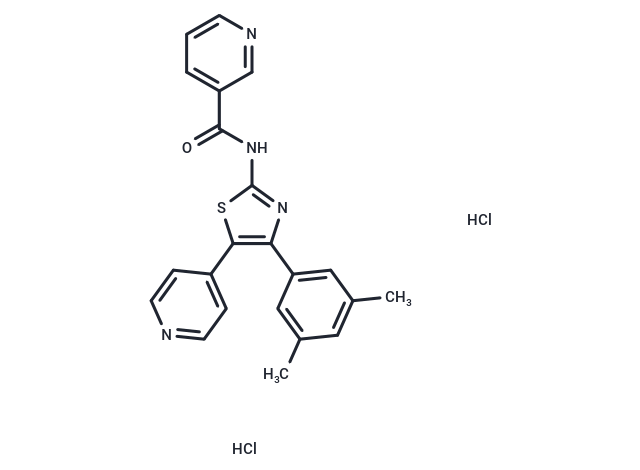Shopping Cart
Remove All Your shopping cart is currently empty
Your shopping cart is currently empty
DPTN dihydrochloride is a potent and selective A3AR antagonist with Ki values of 1.65, 9.61 and 8.53 nM in human, mouse and rat, respectively.

| Pack Size | Price | USA Warehouse | Global Warehouse | Quantity |
|---|---|---|---|---|
| 1 mg | $43 | - | In Stock | |
| 5 mg | $98 | - | In Stock | |
| 10 mg | $168 | - | In Stock | |
| 25 mg | $365 | - | In Stock | |
| 50 mg | $562 | - | In Stock | |
| 100 mg | $790 | - | In Stock | |
| 500 mg | $1,670 | - | In Stock |
| Description | DPTN dihydrochloride is a potent and selective A3AR antagonist with Ki values of 1.65, 9.61 and 8.53 nM in human, mouse and rat, respectively. |
| Targets&IC50 | A3 (human):1.65 nM (Ki) |
| In vitro | DPTN dihydrochloride is a potent antagonist of human, mouse, and rat A3AR. However, compared with human A3AR, DPTN dihydrochloride has a weaker effect and reduced selectivity in mice and rats (approximately 20 times that of A2BAR).[1] The binding affinity test of DNPT (10 μM) on the cell membrane of transfected HEK293 cells showed that its Ki values for hA1, hA2A, hA2B and hA3 were 162±49, 121±42, 230±40 and 1.65±0.57 nM respectively[ 1]. The Ki values of DPTN dihydrochloride at A1, A2A, A2B and A3 receptors are 411, 830, 189 and 9.61 nM (mouse); 333, 1147, 163 and 8.53 nM (rat) respectively.[1] |
| Molecular Weight | 459.39 |
| Formula | C22H20Cl2N4OS |
| Cas No. | 325767-87-1 |
| Smiles | O=C(C1=CC=CN=C1)NC2=NC(C3=CC(C)=CC(C)=C3)=C(C4=CC=NC=C4)S2.Cl.Cl |
| Relative Density. | no data available |
| Storage | Powder: -20°C for 3 years | In solvent: -80°C for 1 year | Shipping with blue ice/Shipping at ambient temperature. | |||||||||||||||
| Solubility Information | DMSO: 2.3 mg/mL (5.01 mM), Sonication is recommended. | |||||||||||||||
Solution Preparation Table | ||||||||||||||||
DMSO
| ||||||||||||||||
| Size | Quantity | Unit Price | Amount | Operation |
|---|

Copyright © 2015-2026 TargetMol Chemicals Inc. All Rights Reserved.